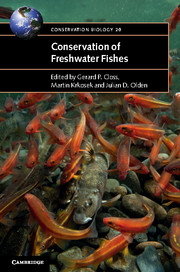Book contents
- Frontmatter
- Contents
- List of contributors
- Preface
- 1 Lost fishes, who is counting? The extent of the threat to freshwater fish biodiversity
- 2 Why are freshwater fish so threatened?
- 3 Climate change effects on freshwater fishes, conservation and management
- 4 Challenges and opportunities for fish conservation in dam-impacted waters
- 5 Chemical pollution
- 6 Multiple stressor effects on freshwater fish: a review and meta-analysis
- 7 Infectious disease and the conservation of freshwater fish
- 8 Non-indigenous fishes and their role in freshwater fish imperilment
- 9 Riparian management and the conservation of stream ecosystems and fishes
- 10 Fragmentation, connectivity and fish species persistence in freshwater ecosystems
- 11 Conservation of migratory fishes in freshwater ecosystems
- 12 Protecting apex predators
- 13 Artificial propagation of freshwater fishes: benefits and risks to recipient ecosystems from stocking, translocation and re-introduction
- 14 Freshwater conservation planning
- 15 Sustainable inland fisheries – perspectives from the recreational, commercial and subsistence sectors from around the globe
- 16 Understanding and conserving genetic diversity in a world dominated by alien introductions and native transfers: the case study of primary and peripheral freshwater fishes in southern Europe
- 17 Maintaining taxonomic skills; the decline of taxonomy – a threat to fish conservation
- 18 Synthesis – what is the future of freshwater fishes?
- Index
- References
8 - Non-indigenous fishes and their role in freshwater fish imperilment
Published online by Cambridge University Press: 05 December 2015
- Frontmatter
- Contents
- List of contributors
- Preface
- 1 Lost fishes, who is counting? The extent of the threat to freshwater fish biodiversity
- 2 Why are freshwater fish so threatened?
- 3 Climate change effects on freshwater fishes, conservation and management
- 4 Challenges and opportunities for fish conservation in dam-impacted waters
- 5 Chemical pollution
- 6 Multiple stressor effects on freshwater fish: a review and meta-analysis
- 7 Infectious disease and the conservation of freshwater fish
- 8 Non-indigenous fishes and their role in freshwater fish imperilment
- 9 Riparian management and the conservation of stream ecosystems and fishes
- 10 Fragmentation, connectivity and fish species persistence in freshwater ecosystems
- 11 Conservation of migratory fishes in freshwater ecosystems
- 12 Protecting apex predators
- 13 Artificial propagation of freshwater fishes: benefits and risks to recipient ecosystems from stocking, translocation and re-introduction
- 14 Freshwater conservation planning
- 15 Sustainable inland fisheries – perspectives from the recreational, commercial and subsistence sectors from around the globe
- 16 Understanding and conserving genetic diversity in a world dominated by alien introductions and native transfers: the case study of primary and peripheral freshwater fishes in southern Europe
- 17 Maintaining taxonomic skills; the decline of taxonomy – a threat to fish conservation
- 18 Synthesis – what is the future of freshwater fishes?
- Index
- References
Summary
INTRODUCTION
The current state of freshwater biodiversity, and that of freshwater fishes in particular, can only be described as dismal (Dudgeon et al., 2006; Burkhead, 2012; Chapters 1 and 2). Freshwater extinction rates have been estimated to be around 1000× above background extinction rates (Ricciardi & Rasmussen, 1999; Burkhead, 2012). Using North America as an example, a recent American Fisheries Society assessment indicates that 39% of North American freshwater fish taxa are imperilled: 230 are vulnerable, 190 are threatened, 280 are endangered and 61 are extinct or extirpated (Jelks et al., 2008). Global assessments paint the same general picture (www.iucn.org). What are the factors ultimately responsible for this situation? The objective of this chapter is to examine the role of non-indigenous fishes (hereafter NIF) in the decline and imperilment of native freshwater fishes. We provide a short primer to clarify a few key terms relating to invasion biology Box 8.1).
A biological invasion should not be viewed as an event, but rather a process comprised of several successive stages (Figure 8.1). The non-indigenous species introduction process begins with uptake of individuals, transport to a new area (transport outside of native range), and subsequently release into the wild (introduction to the wild). These released individuals may then establish a self-sustaining population in the new area (establishment), and an established population may increase in abundance and expand its geographic range (spread). Typically it is only when a species becomes abundant and/or widespread that it is perceived to cause ecological or economic harm (impact), such that the species is considered invasive (Lockwood et al., 2013). Human values and perceptions greatly influence how and whether a non-indigenous species is viewed as having undesirable consequences. Alternatively, an introduced species population may remain small and localised in its distribution, with few or no tangible ecological or economic effects. To pass through the invasion stages shown in Figure 8.1, a species must overcome a suite of barriers to advancement. At each stage, there are ecological, environmental and stochastic forces that can either facilitate or hinder transition to subsequent stages. These may include the characteristics of the species (e.g. reproductive rate, physiological tolerance), environmental conditions (e.g. temperature or salinity match) and the nature of the introduction event (e.g. timing of introduction, number of individuals moved).
- Type
- Chapter
- Information
- Conservation of Freshwater Fishes , pp. 238 - 269Publisher: Cambridge University PressPrint publication year: 2015
References
- 8
- Cited by



